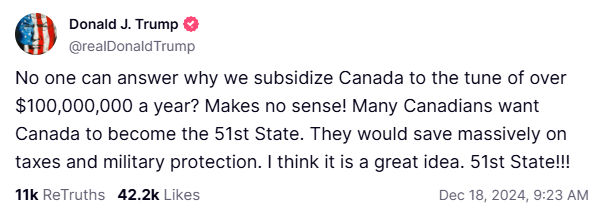SEC Sets Bullish Tone on On-Chain Markets as Blockchain Settlement
How Trump’s tariffs are reshaping Canada’s economic identity
(Originally posted on : Invezz )
The relationship between Canada and the United States has always been one of deep economic ties.
But now, trade tensions have thrown those ties into uncertainty.
US President Donald Trump has threatened sweeping 25% tariffs on Canadian goods, shaking investor confidence and putting Canada’s economic reliance on its southern neighbour under the spotlight.
The temporary pause in tariffs may have offered a moment to breathe, but the damage is already being felt.
Business investment is drying up, industries are rethinking their supply chains, and political leaders are scrambling to respond.
Is Canada too dependent on the US?
Trade has been at the heart of Canada’s economy for decades.
The 1988 Canada-US “Free Trade Agreement” was the beginning of the country’s deep economic integration, which was later strengthened by NAFTA in 1994 and the USMCA in 2020.
Today, 80% of Canada’s exports go to the U.S., making it one of the most trade-dependent economies in the world.
By comparison, Canada accounts for only 3% of the US economy.
The imbalance means the US holds more negotiating power, and Trump’s threats of tariffs have already exposed this weakness in Canada.
With such a heavy reliance on US trade, even the suggestion of tariffs has rattled investor confidence.
If the tariffs go through, Canada could face a severe economic shock, with potential job losses, rising consumer prices, and a slowdown in key industries like manufacturing and energy.
Trump is already aware that he holds the upper hand in this trade relationship, hence why he is claiming he wants to make Canada the “51st State.”
The trade deficit myth
Trump has framed the US trade deficit with Canada as proof that America is “subsidizing” its northern neighbor.
He has claimed the deficit is as high as $200 billion, although the actual figure in 2024 was $63 billion, which is just a fraction of the US’s overall $1.2 trillion trade deficit.

More importantly, trade deficits are not subsidies.
The US runs a trade deficit because it consumes more than it produces, not because of unfair trade policies.
According to the US Census Bureau, Canada remains the largest buyer of US goods, purchasing $349.4 billion worth in 2024, more than Mexico or China.
At the same time, the US benefits from cheap Canadian exports, particularly oil and aluminum, which lower production costs for American industries.
Investment is already leaving Canada
The uncertainty alone has been enough to drive businesses out.
A recent KPMG survey found that nearly half of Canadian businesses plan to shift production or investment to the US to avoid potential tariffs.
This is particularly the case in the auto industry, where companies rely on seamless cross-border supply chains.
Auto parts made in Ontario can cross the border up to eight times before final assembly, meaning new trade barriers would significantly increase costs.
The Bank of Canada recently cut interest rates, partly in response to weakening business investment.
GDP per capita has declined in eight of the last nine quarters, and economists warn that Canada’s economy is ill-prepared for a trade war.
If investment continues to decline, job creation could slow, and economic growth could stagnate.
The energy factor: can Canada find new buyers?
One of Canada’s biggest exports to the US is energy.
Oil, natural gas, and electricity make up about one-third of Canada’s total exports.
If the U.S. imposes tariffs on these commodities, Canada could struggle to find alternative markets.
The country lacks the infrastructure to quickly redirect oil shipments to Asia or Europe.
At the same time, US refiners are heavily dependent on Canadian heavy crude, which their facilities are specifically designed to process.
While the US has ramped up domestic oil production, it still relies on Canadian imports to balance its refining needs.
Shutting off Canadian oil would create major disruptions in the US energy market, making it an unlikely target for tariffs.
A wake-up call for Canada’s economy
The biggest lesson from this crisis is that Canada needs to diversify its trade relationships.
Successive governments have talked about reducing dependence on the US, but little progress has been made.
Infrastructure constraints, regulatory barriers, and a lack of international trade agreements have kept Canada locked into its current trade patterns.
One immediate policy response has been renewed talks about removing interprovincial trade barriers.
Provinces are beginning to recognize that internal trade must improve if the country is to become more resilient.
There is also growing political will to invest in infrastructure, such as pipelines and ports, that could help Canada expand its reach to global markets.
The next Canadian government will have to make this crisis a top priority.
Economic resilience will require a mix of trade diversification, infrastructure investment, and regulatory reform.
Canada may not be able to escape its economic ties to the US, but it can certainly work toward reducing its vulnerability.
The post How Trump’s tariffs are reshaping Canada’s economic identity appeared first on Invezz







 Bitcoin
Bitcoin  Ethereum
Ethereum  Tether
Tether  XRP
XRP  USDC
USDC  Lido Staked Ether
Lido Staked Ether  TRON
TRON  Dogecoin
Dogecoin  Cardano
Cardano  Figure Heloc
Figure Heloc  WhiteBIT Coin
WhiteBIT Coin  Wrapped stETH
Wrapped stETH  Bitcoin Cash
Bitcoin Cash  Wrapped Bitcoin
Wrapped Bitcoin  USDS
USDS  Chainlink
Chainlink  Wrapped eETH
Wrapped eETH  Binance Bridged USDT (BNB Smart Chain)
Binance Bridged USDT (BNB Smart Chain)  LEO Token
LEO Token  WETH
WETH  Hyperliquid
Hyperliquid  Monero
Monero  Stellar
Stellar  Zcash
Zcash  Coinbase Wrapped BTC
Coinbase Wrapped BTC  Ethena USDe
Ethena USDe  Litecoin
Litecoin  Sui
Sui  Avalanche
Avalanche  Hedera
Hedera  Shiba Inu
Shiba Inu  sUSDS
sUSDS  USDT0
USDT0  Dai
Dai  Mantle
Mantle  Toncoin
Toncoin  World Liberty Financial
World Liberty Financial  PayPal USD
PayPal USD  Cronos
Cronos  Uniswap
Uniswap  Ethena Staked USDe
Ethena Staked USDe  Polkadot
Polkadot  MemeCore
MemeCore  Aave
Aave  Bittensor
Bittensor  USD1
USD1  Canton
Canton  Rain
Rain  Bitget Token
Bitget Token  OKB
OKB  Tether Gold
Tether Gold  Falcon USD
Falcon USD  Aster
Aster  NEAR Protocol
NEAR Protocol  Ethereum Classic
Ethereum Classic  Binance-Peg WETH
Binance-Peg WETH  Ethena
Ethena  Jito Staked SOL
Jito Staked SOL  Pepe
Pepe  BlackRock USD Institutional Digital Liquidity Fund
BlackRock USD Institutional Digital Liquidity Fund  Internet Computer
Internet Computer  Pi Network
Pi Network  Pump.fun
Pump.fun  Wrapped SOL
Wrapped SOL  Jupiter Perpetuals Liquidity Provider Token
Jupiter Perpetuals Liquidity Provider Token  syrupUSDC
syrupUSDC  HTX DAO
HTX DAO  PAX Gold
PAX Gold  Ondo
Ondo  Worldcoin
Worldcoin  Global Dollar
Global Dollar  KuCoin
KuCoin  Circle USYC
Circle USYC  Sky
Sky  syrupUSDT
syrupUSDT  BFUSD
BFUSD  Ripple USD
Ripple USD  Rocket Pool ETH
Rocket Pool ETH  Binance Bridged USDC (BNB Smart Chain)
Binance Bridged USDC (BNB Smart Chain)  POL (ex-MATIC)
POL (ex-MATIC)  Aptos
Aptos  Gate
Gate  Arbitrum
Arbitrum  Wrapped BNB
Wrapped BNB  Quant
Quant  Binance Staked SOL
Binance Staked SOL  Midnight
Midnight  Official Trump
Official Trump  Algorand
Algorand  Cosmos Hub
Cosmos Hub  Function FBTC
Function FBTC  Liquid Staked ETH
Liquid Staked ETH  VeChain
VeChain  Lombard Staked BTC
Lombard Staked BTC